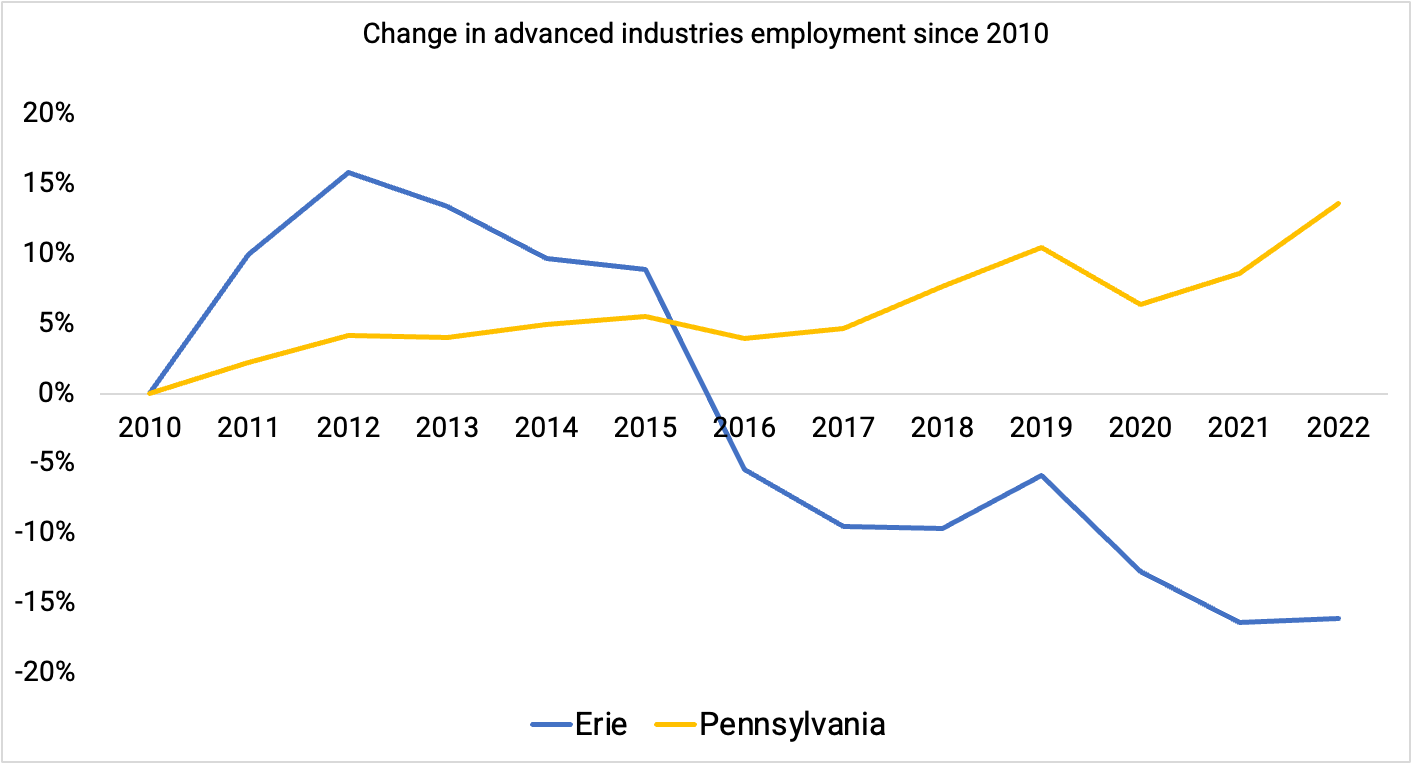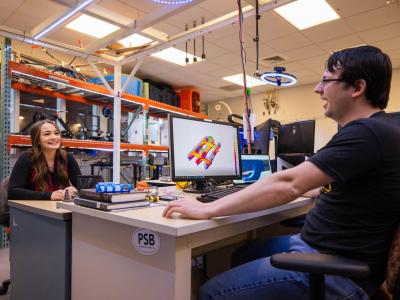Innovating Our Regional Economy: Building on Our Strengths
To imagine where Erie's headed, economists look to the past
"Stable, but slightly sluggish."
That is how economist Ken Louie told me he sees the overall state of the economy in Erie during a recent Zoom call.
"We are probably less sluggish than we had been – that's two negatives there. So to say it in a more positive way: We are, I think, growing at a little bit faster pace than we had been before," Louie, the director of the Economic Research Institute of Erie (ERIE) at Penn State Behrend, said. "It's still too early to tell, because it hasn't been that long since we've had that dramatic drop."
The drop Louie was referring to came as the COVID-19 public health crisis began to have a pronounced impact on global, national, state, and local economies. According to the U.S. Bureau of Labor Statistics, Erie's unemployment rate reached 16.8 percent in April 2020 – a half of a percent higher than Pennsylvania's unemployment rate at the same time, and more than 2 percent higher than the U.S.'s national average.
One way of understanding the "stable" part of Erie's economy today, as Louie describes it: unemployment in June 2023 has dropped from nearly 17 percent to 4.2 percent. In Pennsylvania, at the same time the data was recorded, unemployment dropped to 3.8 percent and to 3.6 percent at the national level.
But, sluggish?
Comparing January 2020 (pre-economic impact from the pandemic) to June 2023 (the most recent data Louie presented at ERIE's annual conference in July), Erie recovered 97 percent of its total nonfarm employment. The U.S. economy, however, is nearly 3 percent higher in June 2023 than January 2020.
"If you are a pessimist, you would say, 'Well, the U.S. economy has already gone beyond the pre-pandemic employment level,'" Louie told me. "But if you are a more optimistic individual then the observation is that the movement has been a continual upward movement – even though it's been a very, very sluggish pace."
It stands to reason that, over time, Erie's economy will get back to, and then potentially exceed, where it was just three years ago. How much time that will take remains unclear.
The 64 thousand, er, million dollar (adjusted for inflation) question, now, is: Why is the Erie economy sluggish? There are, of course, many factors, but Louie points to a need to strengthen the region's ability to create more jobs.
"Jobs are the ultimate source of other positive effects, because jobs create income, income generates purchasing power, purchasing power stimulates business activity in terms of new business, startups, investments, expansions," Louie said.
"One of the most rational strategies [to generate more jobs] is this emphasis on innovation hubs," Louie told me, pointing both to an October 2022 report published by the Brookings Institution and to Penn State Behrend's new Project Resolve initiative. That is, rather than a scattershot approach to economic development (i.e. casting wide nets), take a targeted approach and, say, cast specific lines to work on reeling in specific catches.
 According to Brookings' analysis of data from Lightcast, between 2010 and 2022, the Erie metro area lost about 2,200 advanced industries jobs, as opposed to the rest of the state which added about 55,000 jobs. (Brookings analysis of data from Lightcast)
According to Brookings' analysis of data from Lightcast, between 2010 and 2022, the Erie metro area lost about 2,200 advanced industries jobs, as opposed to the rest of the state which added about 55,000 jobs. (Brookings analysis of data from Lightcast)
Local Spark Plugs Helping to Jumpstart the State's Innovation Economy
Authored by Mark Muro, Rob Maxim, and Yang You, Commonwealth of Innovation: A Policy Agenda for Revitalizing Pennsylvania's Economic Dynamism makes the case that despite its asset-rich position (world-class research universities, break-out companies, diverse, talented workforce in both urban centers and rural areas), "Pennsylvania has not been able to convert its assets into abundant, high-quality economic growth or broad-based employment across an array of high-tech, high-pay advanced industries." Peer states are outpacing the commonwealth, and if nothing changes, Pennsylvania might continue drifting along at best – or at worst, decline.
The report makes key recommendations on how to invigorate Pennsylvania's economy – the new state administration must make a commitment to advance innovation with policy and investments, accelerate commercialization and growth in the state's major innovation metro areas, foster innovation and entrepreneurship outside of major metro areas, and insist on inclusion in growing its innovation economy.
The recommendations come with concrete examples of what is already working, and how such examples could work on larger scales and elsewhere. One such example is The Northwest Pennsylvania Innovation Beehive Network, a collaborative, innovation-rich partnership between area universities and the county's public library to create an ecosystem capable of generating economic development output similar to that of a Research 1-level university (which Erie does not have).
"Erie has put itself in a good position with admirable initiatives such as the Beehive effort," Muro, a senior fellow at Brookings told me on a recent Zoom call. "And the work of Penn State Behrend over a long time is one of the sources that I think Rob and I saw that gave us confidence that the medium-sized and smaller regions can play in the kind of innovation game that we think is the right place for Pennsylvania to play over time."
On the same call, Maxim, a Brookings senior research associate told me, "[the Erie] region is doing a lot on its own to start changing that kind of fundamental underlying metric that dictates the future of your region's innovation economy."
"Erie is one of the sources of the kind of innovation that we are arguing for," Muro added.
What Muro and Maxim are watching now is the attention being paid to the state's innovation economy by the Shapiro administration. With just eight months in office, and its first state budget much younger, it is too soon to expect significant changes, but Muro and Maxim told me they're encouraged so far. What's more encouraging: imagining state-level policy that benefits places like Erie to a whole-of-region, and thus a whole-of-state approach to economic development in the innovation ecosystem.
Building a Stronger Future on Past Foundations: Project Resolve
"Project Resolve," which Louie chose as the theme for this year's ERIE conference, "is probably the best recent example that I can think of that follows along that model of developing an innovation hub that really is very, very focused," Louie told me.
That focus means cultivating the strength of two areas in which Erie has been historically economically strong: plastics and metal casting.
According to Penn State Behrend's website, "Project Resolve is a regional strategy for shifting the plastics, metal-casting, and transportation industries to a circular economic model to address plastic and waste pollution that ultimately affects the health of freshwater supplies such as Lake Erie. Resolve will advance manufacturing competitiveness and environmental vitality in parallel rather than in traditionally oppositional actions."
The five elements of the 10-year, $120 million regional strategy include a new Center for Manufacturing Competitiveness, Lake Erie Data Collection and Transfer, Regional Growth Cluster Placemaking, and the NWPA Innovation Beehive Network.
The Erie Investment Playbook (2022), now known as Infinite Erie, identified it as a high-profile, shovel-ready project. And it aligns with recommendations proposed in the Comprehensive Economic Development Study released in 2012 and 2022 by the Northwest Commission and the "Commonwealth of Innovation" report, which, as Penn State Behrend's website acknowledges, "found that advanced industry employment in Pennsylvania has declined over the past decade, particularly in Erie County."
According to Brookings' analysis of data from Lightcast, between 2010 and 2022, the Erie metro lost about 2,200 (a 16 percent decline) advanced industries jobs while the state added about 55,000 jobs (a 14 percent increase). Yet, the plastics manufacturing industry, the region's largest advanced industry in 2022, gained more than 700 jobs and accounted for 32 percent of the total advanced industries workers in the region.
And that focus compliments wide-ranging economic development initiatives already underway.
"We're all impatient to see the whole community get better economically," Louie told me. "Project Resolve, I think, has the advantage that it forces us to focus in on the strengths."
Unleashing Erie's Economic Potential
Like knowing what the direction and impact of the state government's focus on innovative economy, in light of the Brookings report, and knowing the long-ranging impact of the COVID-19 pandemic on local, state, national, and global economies, it is, of course, too early to know what the impact of Project Resolve will be. The work there has just recently begun.
But it isn't hard to imagine, and to be optimistic about Erie's future.
Louie told me that every year, when he puts the conference together, he spends a lot of time contemplating the title that distills the essence of what he wants the community to learn. This year's title: "Unleashing Erie's Economic Potential: Harnessing the Region's Strengths through Project Resolve." Sometimes to look forward, it helps to look behind – to know where you've been in order to understand where you are, to plot and plan where you want to go.
Ben Speggen can be reached at bspeggen@eriereader.com




